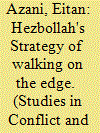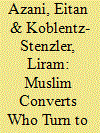| Srl | Item |
| 1 |
ID:
172824


|
|
|
|
|
| Summary/Abstract |
Terrorists are using social media for the mass dissemination of terrorism-supporting messages. Activating the “long arm of the law” mechanism over media corporations, similar to that in the financial sector, will help to eradicate this phenomenon. The article describes the structure of a holistic framework that expands legal liability for the publication of terrorism-supporting content so that it applies to the entire chain of participants facilitating its distribution: the corporation, the platform, the Web-user publishing the content, and the Web-user viewing the content. The article proposes an adaptation of criminal legal tools at the state and international levels, as well as tools from the field of civil law; finally, the article argues that civil society also has the power to generate social change and to shape a mindset that imposes corporate liability on user content.
|
|
|
|
|
|
|
|
|
|
|
|
|
|
|
|
| 2 |
ID:
116221


|
|
|
|
|
| Publication |
2012.
|
| Summary/Abstract |
Since entering Lebanese politics in the 1990s, Hezbollah has defined itself as a political party that plays by the rules. Simultaneously, it has continued to use social assistance to win over Lebanon's Shi'ites while using violence to eliminate rivals. Through this strategy of "walking on the edge," Hezbollah has metamorphosed from an illegitimate terrorist organization into a legitimate political party heading Lebanon's government. An International Tribunal's recent indictment of four senior Hezbollah officials for involvement in the murder of former Lebanese Prime Minister Rafiq Al-Hariri provides an opportunity to understand how Hezbollah maintains this canny-and successful-balancing act.
|
|
|
|
|
|
|
|
|
|
|
|
|
|
|
|
| 3 |
ID:
124194


|
|
|
|
|
| Publication |
2013.
|
| Summary/Abstract |
Since 1982, Hezbollah has evolved from a "revolutionary vanguard" terrorist organization bent on violently overthrowing the Lebanese government to a hybrid terrorist organization that uses legitimate political tools to the same end. Today Hezbollah operates on the civilian plane of da'wa, social welfare, and religious education; the military-Resistance plane (jihad); and the political plane. In its drive to dominate Shi'ite society, Hezbollah overcame its chief rival, Amal, and now plays a decisive role in Lebanon's political system and the Middle East. Understanding Hezbollah's emergence as a prototypical hybrid terrorist organization is key to understanding global and local jihad movements.
|
|
|
|
|
|
|
|
|
|
|
|
|
|
|
|
| 4 |
ID:
187996


|
|
|
|
|
| Summary/Abstract |
Over the past three decades, along with the expansion of the phenomenon of global jihad, we have witnessed a growing trend of converts to Islam integrating into global jihad organizations. Some of these converts constitute an important element in the terrorist infrastructure, globally, and particularly in the West. Some are recruited as foreign fighters into the ranks of the Islamic State or other Islamic extremist organizations. Global jihad organizations have identified the potential of new converts (knowledge of the local culture, the difficulty in tracking them faced by intelligence organizations), and they are investing efforts in every possible arena (physical and digital) to recruit them for terrorist activity. The converts, for their part, are more vulnerable to recruitment for terrorist purposes. The aim of the article is to illuminate the existing phenomenon of radicalization among new converts to Islam and expand the current knowledge base with regard to the variables that affect the growth of this phenomenon and the background and preconditions for such growth. Moreover, this article will attempt to use the above in order to design and develop effective tools for early warning and curbing this phenomenon.
|
|
|
|
|
|
|
|
|
|
|
|
|
|
|
|